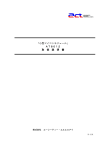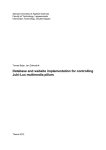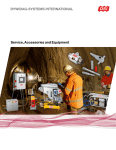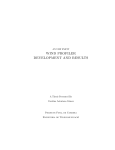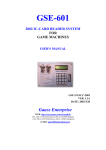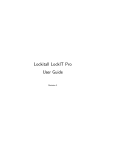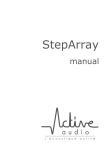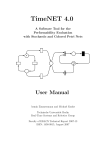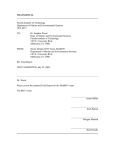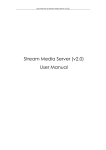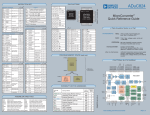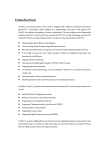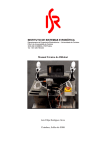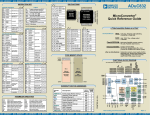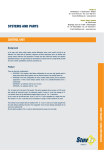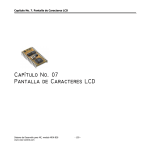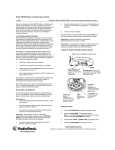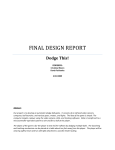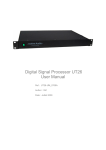Download Fresh Water Aquarium Monitor Team Name: “Finding Nemo”
Transcript
EEL 4914 Senior Design Final Design Report December 5th Fall 2007 Fresh Water Aquarium Monitor Team Name: “Finding Nemo” Submitted by: Mike Arms [email protected] 727.560.1663 Beth Spalding [email protected] 352.870.7232 Table of Contents I. II. III. IV. V. VI. VII. VIII. IX. X. XI. XII. XIII. XIV. INTRODUCTION ABSTRACT TECHNICAL OBJECTIVES PROJECT FEATURES CONCEPT/TECHNOLOGY PRODUCT COMPARISON PROJECT ARCHITECTURE HARDWARE/SOFTWARE DESIGN PROCEDURE FLOWCHARTS/DIAGRAMS BILL OF MATERIALS USER MANUAL GANTT CHART/RESPONSIBILITIES APPENDICIES 1 1 2 2 3 5 6 8 13 14 15 16 19 21 I. INTRODUCTION This project has very practical applications to almost every individual who has interest in owning a fresh water aquarium or who already owns a fresh water fish aquarium. For example, if a family leaves their home for a week long vacation, instead of trying to find someone to care for the aquarium while they are away, the fish monitor will feed the fish, monitor the temperature and PH levels, and adjust accordingly. This device will have great value for those individuals who value the health of their fresh water friends. Existing commercial products are very costly and provide many features that the average aquarium owner may not use or need. Commercial available features include password protection, water conductivity, weather simulation, sunrise and sunset simulation, and ORP (oxidation reduction potential). All of these features are excess for the average owner. Costs range anywhere from $150 upwards to $400, more than an owner would want to pay if their aquarium only cost around $50. Our product will minimize cost and provide only the basic features needed to successfully monitor and maintain a fresh water aquarium. II. ABSTRACT This project was realized over the summer when a close friend received a fresh water aquarium as a gift. One afternoon, the fish were found with small white spots all over them. It turned out to be a bacterial infection and something that could have easily been prevented if the water temperature was kept between a certain levels. Project “Finding Nemo” aims to monitor and control the temperature, PH levels, and feed the fish in a fresh water fish aquarium. The temperature will be monitored using a basic temperature sensor and the temperature adjustment will be performed by turning on or off a light. The PH levels will be monitored using a color sensor and the levels will be adjusted according to the user’s discretion. The technical challenges this team will face is programming the monitor for temperature and PH, and working with the color sensor. Typical PH sensors are difficult to work with and on average, last only a year. At the end of the term, this outcome we expect is to build a working aquarium monitor to monitor the temperature and PH levels within the tank. The device will be able to store user input as to when and how often the fish will be fed, at what temperature the water should be kept, and the required PH levels. It will a provide feedback of the current levels and adjust the temperature accordingly if the levels are out of the specified user input. III. TECHNICAL OBJECTIVES This project will use basic DC wall power. There will be a temperature sensor to monitor the water and another sensor to measure the pH. The pH levels can be adjusted at the user’s discretion while the temperature will be corrected automatically. A step motor will be used to dispense food. A microprocessor will take in the data from the sensors and output the data to an LCD screen. The user will input the range of acceptable conditions of the aquarium as well as the desired number of feedings per day on a keypad. IV. PROJECT FEATURES In order to minimize cost and facilitate ease of use, this product will have the necessary, but minimal features. Main Objective Our goal is to market this product to the average aquarium owner, so a basic, userfriendly product is a must. Features LCD Display – this part of the device will be used to enter user-defined inputs for temperature, pH and fish feeding time, through basic push buttons and display the current temperature and pH levels. Push-Button Input – minimal push-buttons will be used as the means for entering the desired data. Temperature monitoring and control – the device will monitor the temperature of the aquarium and then display the temperature of the aquarium, and if the temperature is out of the user-specified range, the device will turn on/off a lamp to adjust the temperature. PH monitoring – the device will monitor and display the current pH readings and notify the user if the pH is out of the user-defined range. Fish feeder – the device will contain a step motor with rotating cavity to provide food to feed the fish. At the user-defined time, the motor will dispense the food to the aquarium. V. CONCEPT/TECHNOLOGY PIC Microcontroller We chose the PIC over other controllers based on the wide array of features available which are appropriate for the needs of this project. It is widely available, has a very low cost, wide range of available development tools, and the availability of a real-time clock. It has a variety of features including a CPU, RAM, ROM, I/O lines, and can store and run a program. LCD Display A basic LCD display will interface with the PIC Microcontroller in order to display the information pertaining to the temperature and pH sensors. Real-Time Clock We chose to use a separate Real-Time Clock instead of the one on the PIC Microcontroller because it is more stable than the PIC. It is more accurate and will not fluctuate with a change in load. Temperature Sensor This sensor will take analog temperature data and then convert the value to a digital format through the use of the microcontroller. There are many temperature sensors available that easily interface with the PIC Microcontroller. We chose a Fahrenheit temperature sensor because converting to Kelvin or Celsius with the PIC loses some accuracy in the decimal place. PH sensor PH sensors test how basic or acidic the liquid is and can be translated into a concentration of hydrogen ions. The measurement ranges between 0 and 14. A very acidic solution has a low pH value from 0 to 2, corresponding to a large concentration of hydrogen ions. A basic solution has a high pH value from 12 to 14, corresponding to a small number of hydrogen ions. It is important to note that over time, the electrical properties in the pH measuring electrodes change, so the electrode will eventually have to be replaced. This makes typical pH sensors unfavorable to use. We chose to use a color sensor instead of the more common pH sensors because of its wide range of uses, consistent readings and the fact that it will not need to be replaced, unlike basic pH sensors. The current method for testing the pH is adding the appropriate chemicals to a small vial of the aquarium water and then inserting it into the pH testing device, where the color sensor reads the intensity of the water color in the vial and displays the results on the LCD. The color sensor could also be adapted to test for ammonia and nitrate levels. Stepper Motor The stepper motor is ideal for feeding the fish. A stepper motor will run after a pulse of electricity and this pulse will rotate the motor by a predefined increment in a step fashion and has a high degree of precision. By using the step motor, we will be able to control precisely how much food we want to feed the fish and while using minimal power, unlike other types of motors. VI. PRODUCT COMPARASION After deciding on this design product, we researched to see if there were any comparable existing products. We can see from the monitors introduced below that they are not only expensive, but have many more features than the average aquarium owner would need. Digital Aquatics ReefKeeper 2 (AquaDirect Link) Features – fully enclosed stand-alone device. PH monitor, interface with PC, several channels, different modes, timers, wavemaker, digital thermometer and temperature control, fan/chiller control, high power Cost - $49.00 AquaController Jr, 3 and 3 Pro (Neptune Systems Link) Features – fully enclosed, stand-alone device. This device includes pH, Temperature, ORP, Cond and DO monitoring and control, Ethernet port, e-mail alarms, telnet server, lighting control, wavemaker, seasonal variations, digital calibration (a picture of each device is shown below). Cost – $149.95 to $649.95 VII. PROJECT ARCHITECTURE PCB Schematic Project Architecture – A high level description of how the parts in your project work together. VIII. HARDWARE/SOFTWARE PIC Microcontroller We chose to use the PIC18F4620 because it is the largest one available with a wide range of features required for our design. - Operating voltage: 2.0V to 5.5V - Internal real-time clock and oscillator - 10-bit ADC, 13 channels at 100K samples per second - Program Memory: 65536 bytes - RAM size: 3968 bytes - EEPROM data size: 1024 bytes - I/O pins: 36 Figure – PIC18F4620 Pin-out LCD Display The LCD display provided in the senior design class was very basic and provided two lines with twenty characters each, which is sufficient for our design. Figure – 20x2 LCD Screen and Device Front Panel Real-Time Clock We used the PCF8583 to keep track of time and to store memory that needed a battery back-up. Temperature Sensor Since we wanted to display the temperature in Fahrenheit, the LM34 temperature sensor was the most feasible solution. It was very inexpensive and widely available. The output voltage of the sensor is linearly proportional to the Fahrenheit temperature on a 10.0mV/°F scale, has a range of -50°F to 300°F range, has low self heating, and does not require any outside calibration or programming conversions to obtain the correct value. The figure below shows the configuration for a basic temperature sensor and its corresponding current and temperature curve. For the basic configuration without using any resistors, the temperature range stops at 0°F, which is sufficient because the temperature of the fish tank is not expected to drop below 65°F. Figure – LM34 Fahrenheit Temperature Sensor DIP and Curve PH sensor The TCS230 was used to read the color of the pH from a standard liquid test kit. The color sensor outputs a PMW signal that is read by the microprocessor. As the intensity of the red, green, or blue light increases the pulse widths get smaller. The time between two pulses is measured of one particular color and then compared to that of the other colors. The ratio is used to determine the shade of the color. The vial containing the water to be tested and pH chemicals will be inserted into the opening at the face of the device. A diagram of the color sensor compartment can be seen in Figure X. The color sensor will then take samples of the color in the vial and output the results to the LCD. If the pH is out of the desired range, the user can make the decision to adjust the pH of the water. Figure. PH Sensor Enclosure with Color Sensor and Test Vial. Many samples were recorded of solutions varying in pH. The samples were grouped to what they appear to represent on the color chart. The data was plotted and equations were calculated. The red to green ratio was the best fit and most predictable. This equation was implemented into the Microprocessor. 5.25 5 4.75 4.5 4.25 4 3.75 3.5 3.25 3 2.75 y = 1.2504x - 6.2334 2.5 R2 = 0.9912 2.25 2 1.75 1.5 1.25 1 0.75 0.5 0.25 0 5.8 6 6.2 6.4 6.6 y = 0.0002e1.349x R2 = 0.9666 R/G vs pH R/B vs pH G/B vs pH Linear (G/B vs pH) Expon. (R/B vs pH) Linear (R/G vs pH) y = 0.6339x - 3.5348 R2 = 0.9241 6.8 pH 7 7.2 7.4 7.6 7.8 8 This technology can also be adapted to testing for Ammonia, Nitrate and Oxidation levels, as the less advanced method of using test strips or litmus paper is the same method to test for pH. These elements will obtain a certain color depending on the level of each in the water, and the color sensor can be programmed to identify the range for those elements. Stepper Motor A stepper motor is an electromechanical device that rotates in discrete angular steps. The angle of rotation is dependent on the sequence of pulses applied at the input. It has very precise control and is ideal for this situation because the fish feeding mechanism needs precise and limited rotation. We are using the 20M020D1B bipolar, two-phase stepper motor which has 18º of precision, meaning each step it rotates 18º. In conjunction we are also using a FAN8200 low voltage stepping motor driver. The device we built to contain the fish food and dispense it to the fish tank has four compartments with dividers located 90 º apart. This means we need 90º/18º = 5 steps in order to rotate enough to dispense the food. The first figure is a drawing of the feeding mechanism. There is a food reservoir that holds the food until the dispenser is rotated. After the stepper motor rotates the dispenser, gravity brings food into the next empty compartment. Figure – Feeding Mechanism A certain sequence is required in order to power the stepper motor. A signal is sent from the PIC through the driver and then the output to the driver moves the stepper motor. The driver is basically two logic flip-flops or four inverters. The motor is energized in full step mode, meaning two phases can be energized at a given time. A diagram of the driver and the input and output sequences required to power the motor is shown below. Once the entire device is set up on the fish tank with food in the food reservoir, the motor will need to rotate the dispenser once in order for the food to be on either the 0 or 180 mark; this way, once the set time is reached to feed the fish, the food will dispense properly. Figure – Stepper Motor Driver and Input and Output Sequence IX. DESIGN PROCEDURE Once we came up with an idea for a project, we brainstormed about features and hardware we would need to implement the task. Since we knew what features we wanted – temperature and pH sensing, automatic feeding and a basic user interface, we researched available options for these features. We decided on each hardware device based on the project needs. We chose the PIC 18F4620 after adding up the I/O pins we would need – we originally calculated around 20 I/O pins and ended up using all but two of the pins. We chose the LM34 temperature sensor because of its ease of use and the fact that the output voltage is linear to the Fahrenheit. We chose a stepper motor for the fish feeder because it has very precise control. After doing extensive research on pH sensors, we found a new approach to testing the pH – using a color sensor. Later in the semester we also realized that the color sensor could also be adapted to test for Ammonia levels, Nitrate levels and other chemicals typically adjusted in aquariums. We used a separate real-time clock due to its stability. Once we received all the parts, we split the responsibilities between the two of us and programmed on two breadboards. That way, each individual was in charge of certain aspects of the project, and if one of the breadboards or one of the components on the board failed, we wouldn’t have to move the entire project to a new board or risk damaging other components. For the enclosure, we chose materials that were easy to work with. The plastic housing was purchased for a local retailer and was easy to drill and cut holes for the components. We used balsa wood for the rotating portion of the feeder, once again, because it was easy to shape. A basic funnel was the container to hold the fish food. X. Flowcharts & Diagrams LCD Light Keypad PIC Microcontroller 120 VAC Relay Feeder Motor Temperature Sensor pH Sensor X. BILL OF MATERIALS PIC Microcontroller Temperature Sensor Color Sensor RTC Transistor Diode Cap (0.1 uf) Cap (0.47 uf) Cap electrolytic (33uF) Resistor (10K) Resistor (4.7k) Resistor (1K) Motor Relay Fuse LCD Motor Driver Crystal Oscillator Potentiometer Total Cost P/N 18F4620 LM34 TCS230-LM 8583 2N3189 1N4148 OUZ-SS-105D FAN8200 S591 6P320K Price per Amount Each Total 1 $10.20 $10.20 2 $2.51 $5.02 1 $59.95 $59.95 1 $2.48 $2.48 1 $0.75 $0.75 4 $0.10 $0.40 5 $0.25 $1.25 1 $0.20 $0.20 1 $0.12 $0.12 2 $0.30 $0.60 3 $0.30 $0.90 1 $0.80 $0.80 1 $19.60 $19.60 1 $1.15 $1.15 1 $2.87 $2.87 1 $10.00 $10.00 1 $0.80 $0.80 1 $1.16 $1.16 1 $3.00 $3.00 $121.25 This cost, $121.25, is in the range between the two lowest priced competing products. The color sensor was the most expensive part in this design. If we had decided to use the more common pH sensor, the cost would be cut significantly, but the pH leads would have to be replaced often which would increase the price over time. The product with the color sensor might be more expensive, but it requires little to no maintenance and can be kept in full working condition for years. XII. USER MANUAL XIII. Gantt Chart Task Name Project Research Preliminary Design Report Order Parts Circuit Design Breadboard (Preliminary Assembly) Programming Preliminary Debug MIL PCB Debug/Testing Packaging Fine Tune Project Report Final Presentation 0 1 2 4 4 5 6 7 7 9 9 11 12 Mike 0 0 2 0 0 0 0 1 0 1 0 0 0 Beth 0 2 0 0 0 0 0 0 3 0 0 2 0 Both 1.5 0 0 3 2.5 4 2 0 0 0 2 0 1 1.5 3 4 7 6.5 9 8 8 10 10 11 13 13 RESPONSIBILITIES At the beginning, we had alternately divided up the responsibilities. As the semester went on, we divided up the responsibilities based on strengths and weaknesses. Since Mike had the most programming knowledge and experience, he was responsible for programming the color sensor, real-time clock and user interface for the device. He was also responsible for the physical assembly of the feeder and installing the LCD and buttons for the enclosure. Because Beth has a less diverse programming background, she was responsible for programming the temperature sensors and the motor for the fish feeder. She was also responsible for soldering the components to the PCB board and the majority of the writing. Mike 1. Programming - Color Sensor - Real-Time Clock - User Interface 2. Protel 3. Mechanical Beth 1. Programming - Temperature Sensor - Stepper Motor 2. Soldering board XIV. APPENDICIES '**************************************************************** '* Name : FishMonitor * '* Author : Mike Arms, Beth Spalding * '* Notice : Copyright (c) 2007 * '* : All Rights Reserved * '* Date : 10/9/2007 * '* Version : 1.0 * '* Notes : * '* : * '**************************************************************** DEFINE LCD_DREG PORTA 'LCD data port DEFINE LCD_DBIT 0 'LCD data starting bit 0 or 4 DEFINE LCD_RSREG PORTA 'LCD register select port DEFINE LCD_RSBIT 4 'LCD register select bit DEFINE LCD_EREG PORTB 'LCD enable port DEFINE LCD_EBIT 3 'LCD enable bit DEFINE LCD_BITS 4 'LCD bus size 4 or 8 DEFINE LCD_LINES 2 'Number lines on LCD DEFINE LCD_COMMANDUS 2000 'Command delay time in us DEFINE LCD_DATAUS 50 'Data delay time in us DEFINE HSER_RCSTA 90h DEFINE HSER_TXSTA 20h DEFINE HSER_BAUD 9600 DEFINE HSER_SPBRG 6 DEFINE HSER_CLROERR 1 '*****ALIASES****************************************************** CS_S0 VAR PORTC.0 CS_S1 VAR PORTC.1 CS_INPUT VAR PORTC.2 CS_S2 VAR PORTA.6 CS_S3 VAR PORTA.7 CS_OE VAR PORTC.5 CS_LED VAR PORTC.6 ALERT VAR PORTB.0 LIGHT_EN VAR PORTC.7 SDA VAR PORTC.4 SCL VAR PORTC.3 i2c_read CON 1 i2c_write CON 0 i2c_out VAR BYTE i2c_in VAR BYTE[6] i2c_ack VAR BIT temp VAR WORD UP VAR PORTB.7 DOWN VAR PORTB.6 LEFT VAR PORTB.5 RIGHT VAR PORTB.4 SEL VAR PORTB.1 Position VAR BYTE Hours VAR BYTE Minutes VAR BYTE '****REGISTER CONFIGURATION************************************** OSCCON = %01100010 CCP1CON = %00000101 'Capture on rising edge T3CON = %10000001 T1CON = %10001001 '*********************A/D Setup***************************************** DEFINE ADC_BITS 10 ' Set A/D for 10-bit operation DEFINE ADC_CLOCK 3 ' Set A/D clock DEFINE ADC_SAMPLEUS 50 ' Set A/D sampling time @ 50 uS ' bit# 76543210 ADCON1 = %00001000 ' ADCON1 - A/D control reg 1 ' bit3-0 = 0010, A/D port config, AN0-AN6 analog, ' bit4 = 0, VREF+ = VDD ' bit5 = 0, VREF- = VSS ADCON2 = %10111110 ' bit7: right Justified '*****PORT DIRECTION ASSIGNMENTS********************************** TRISE.0 = 1 ' set RE1/AN5 to input for water temp reading TRISA = %00100000 ' set all of port A output for LCD ' set RA5/AN4 to input for room temp reading TRISB.0 = 0 ' B.0 is output TRISC.2 = 1 'Input for CCP1 TRISC.7 = 0 TRISC.0 = 0 TRISC.1 = 0 TRISC.3 = 0 TRISC.4 = 0 TRISC.5 = 0 TRISC.6 = 0 TRISC.3 = 0 'SCL output TRISB.1 = 1 TRISB.7 = 1 TRISB.6 = 1 TRISB.5 = 1 TRISB.4 = 1 '*****VARIABLES************************************************** '********************Room temp A/D Variable Definitions******************** rsamples VAR WORD ' Multiple A/D sample accumulator rsample VAR BYTE ' Holds number of samples to take rtemp VAR BYTE ' room temp storage rbinary1 VAR BYTE ' storage for binary value rtemp1 VAR BYTE DEG CON 223 ' write a degree mark on the LCD rsamples = 0 '********************Water temp A/D Variable Definitions******************* wsamples VAR WORD ' Multiple A/D sample accumulator wsample VAR BYTE ' Holds number of samples to take wtemp VAR BYTE ' water temp storage wbinary1 VAR BYTE ' storage for binary value wtemp1 VAR BYTE wsamples = 0 H20Temp VAR BYTE 'Variable that holds the set temp TempAdd VAR BYTE TempAdd=$20 'Address on RTC where set temp in backed up '********************Motor Variable Definitions*************************** steps VAR WORD ' storage for the # of steps stepArray VAR BYTE(4) ' sets the number of available arrays run VAR WORD ' storage for variable run steps = 0 ' initializes the step # to zero run = 0 ' initializes the run # to zero 'clear ' clears all registers TRISD = %11110000 ' sets D.0,1,2 to low (output) and the rest high 'CE1 var PORTD.0 'IN1 VAR PORTD.1 'IN2 VAR PORTD.2 'CE2 VAR PORTD.3 stepArray[0] = %00001001 stepArray[1] = %00001011 stepArray[2] = %00001111 stepArray[3] = %00001101 '****CS VARIABLES*********************************************** OldCap VAR WORD NewCap VAR WORD PulseW VAR WORD Red VAR WORD Green VAR WORD Blue VAR WORD T3OF VAR BYTE SampDone VAR BYTE EN_CS VAR BIT pH VAR WORD[2] DONE VAR BIT RG VAR WORD '****RTC VARIABLES************************************************* Address VAR BYTE SAddR VAR BYTE SAddW VAR BYTE Sec1 VAR BYTE Sec10 VAR BYTE Min1 VAR BYTE Min10 VAR BYTE Hour1 VAR BYTE Hour10 VAR BYTE WHour VAR BYTE WMin VAR BYTE IAMPM VAR BIT AMPM VAR BYTE AlarmNum VAR BYTE AlarmAdd VAR BYTE i VAR BYTE AMin1 VAR BYTE 'LCD View of Alarm Contents AMin10 VAR BYTE AHour1 VAR BYTE Ahour10 VAR BYTE AAMPM VAR BYTE AHour VAR BYTE[4] 'Raw Alarm Data AMin VAR BYTE[4] rHours VAR BYTE rMinutes VAR BYTE EN_Alarm VAR BIT Buttons VAR BYTE Busy VAR BIT '*****INTERRUPT INITIALIZATION********************************** ON INTERRUPT GoTo IntHandler INTCON = %11000000 ' Enable global and pir interrupts INTCON.3 = 1 'PORTB INTERRUPT INTCON.0 = 0 'CLEAR PORTBIF IPR1 = %00000100 ' Set CCP to high priority 'PIE2 = %00000010 ' Enable TMR3I 'PIE1 = %00000100 ' Enable CCP1 interrupt PIR2.1 = 0 ' Clear TMR3IF PIR1 = %00000000 ' clear flags '*****MAIN****************************************************** Buttons=PORTB PORTB.0 = 1 T3OF = 0 SAddR = %10100001 'Slave Read SAddW = %10100000 'Slave Write EN_CS = 0 'CS Off AlarmNum = 0 'No Alarms on Fresh Start AlarmAdd = $10 'Address of First Alarm EN_Alarm = 0 'Turn of Alarm Condition Light_EN=0 DONE=0 Busy=0 Pause 2000 GoSub Init_Clock GoSub CS_INT '^^^^^^^^^^^^^^^^^^^^^^^^^^^^^^^^^^^^^^^^^^^^^^^^^^^^^^^^^^^^^^^ Main: GoSub I2C_READ_TIME GoSub WaterTemp GoSub RoomTemp Pause 500 ' Wait 500mS for LCD to startup LCDOut $fe, 1 ' Clear LCD screen Pause 1 ' Wait 1 millisecond LCDOut $fe,$80 ' Move cursor to the beginning of the first line LCDOut DEC1 Hour10,DEC1 Hour1,":",DEC1 Min10,DEC1 Min1,":",DEC1 Sec10, DEC1 sec1, " " IF AMPM == 0 Then LCDOut "AM" Else LCDOut "PM" EndIF LCDOut " ",DEC2 rtemp1,DEG, "F" LCDOut $FE,$C0 LCDOut "Water Temp=", DEC2 wtemp1,DEG, "F" GoTo Main '*****INITIALIZE COLOR SENSOR FOR READING*********************** CS_INT: PIR2.1 = 0 ' Clear TMR3IF PIR1 = %00000000 ' clear flags sampdone = 0 CS_S0 = 0 ' Set division for 1:50 CS_S1 = 1 CS_S2 = 0 's2s3'---red='00', blue='01', clear='10', green='11' CS_S3 = 0 CS_LED = 0 CS_OE = 1 Return '**********************Room Temp Reading Loop************************* RoomTemp: ADCON0 = %00010001 Pause 10 For rsample = 1 TO 20 ' Take 20 samples ADCIN 4, rtemp ' Read analog chan AN4 into rtemp var rsamples = rsamples + rtemp ' Accumulate 20 samples Pause 10 ' Wait 10ms per loop Next rsample rtemp = rsamples/20 ' divide by # of samples rbinary1 = rtemp ' store the number into the binary storage rtemp1 = (rtemp*/500)>>2 rsamples = 0 ' Clear old sample accumulator Pause 75 Return '**********************water Temp Reading Loop*************************** WaterTemp: ADCON0 = %00010101 Pause 10 For wsample = 1 TO 20 ' Take 20 samples ADCIN 5, wtemp ' Read analog chan AN5 into wtemp var wsamples = wsamples + wtemp ' Accumulate 20 samples Pause 10 ' Wait 10ms per loop Next wsample wtemp = wsamples/20 ' divide by # of samples wbinary1 = wtemp ' store the number into the binary storage wtemp1 = (wtemp*/500)>>2 wsamples = 0 ' Clear old sample accumulator Pause 75 Return '*****Get Color Sample******************************************* GetSample: PIR2.1 = 0 ' Clear TMR3IF PIR1 = %00000000 ' clear flags pie2.1 = 1 'Turn on TMR3I PIE1.2 = 1 'Turn on CCPI Done = 0 LCDOut $fe,1 Pause 1 LCDOut $fe, $80 LCDOut "pH = " While Done==0 Wend GoSub DisplayColors Buttons=PORTB 'Reading PortB will update the resting state, avoiding false inturrupts INTCON.0 = 0 Return '***Display Colors************************************************** DisplayColors: 'LCDOut $fe, 1 ' Clear LCD screen 'Pause 1 ' Wait 1 millisecond 'LCDOut $fe,$80 ' Move cursor to the beginning of the first line 'LCDOut "Red=", dec5 Red," ","Blue=", Dec5 Blue 'LCDOut $fe,$c0 ' Move cursor to the beginning of the second line 'LCDOut "Green=", dec5 Green, " " RG=Green/10 IF (Red//RG)>(RG/2) Then RG=8*((Red/RG)+1) Else RG=8*(Red/RG) EndIF pH[0]=(RG/10)+50 pH[1]=pH[0]//10 pH[0]=pH[0]/10 LCDOut DEC1 pH[0],".", DEC1 pH[1] Pause 2000 Return '**********************Fish Feeding Loop********************************* FishFeed: PORTD.0 = 1 PORTD.3 = 1 ' sets portd.0 high for chip enable1 ' sets portd.3 high for chip enable2 For run = 1 TO 5 ' step through the sequence 5 times GoSub motorRun ' go to the subroutine motorRun Pause 150 Next run ' increment the run count Pause 100 PORTD.0 = 0 PORTD.3 = 0 ' sets portd.0 low for chip enable1 to disable ' sets portd.3 low for chip enable2 to disable Return '**********************Motor Rotation Loop******************************* ' Input 1234 Output 1234 ' CE1 1111 Out1 1001 ' IN1 0110 Out2 0110 ' IN2 0011 Out3 1100 ' CE1 1111 Out4 0011 motorRun: Pause 100 steps = steps + 1 PORTD = stepArray[steps //4] Pause 100 Return Enable '#######I2C COMMUNICATION######################################### I2C_READ_TIME: GoSub I2C_START 'Read Time i2c_out=SAddW GoSub I2C_TX i2c_out=$02 'Start reading at Seconds address GoSub I2C_TX GoSub I2C_START i2c_out=SAddR GoSub I2C_TX ShiftIn SDA, SCL, 0, [i2c_in[0]] 'Shift in first byte MSBF ShiftOut SDA, SCL, 1, [%0\1] 'Send ACK = 0 ShiftIn SDA, SCL, 0, [i2c_in[1]] 'Shift in second byte MSBF ShiftOut SDA, SCL, 1, [%0\1] 'Send ACK = 0 ShiftIn SDA, SCL, 0, [i2c_in[2]] 'Shift in first byte MSBF ShiftOut SDA, SCL, 1, [%1\1] 'Send not acknowledge (NACK)=1 GoSub I2C_STOP rMinutes = i2c_in[1] 'raw time data rHours = i2c_in[2] sec1 = i2c_in[0] & %00001111 'LCD viewable Time Format Sec10 = i2c_in[0] >> 4 Min1 = i2c_in[1] & %00001111 Min10 = i2c_in[1] >> 4 Hour1 = i2c_in[2] & %00001111 Hour10= (i2c_in[2] >> 4) & %00000011 AMPM = (i2c_in[2] >> 6) & %00000001 IF AlarmNum !=0 AND AlarmNum <5 Then GoSub I2C_START 'Read Alarms i2c_out=SAddW GoSub I2C_TX i2c_out=$10 'AlarmAdd GoSub I2C_TX GoSub I2C_START i2c_out=SAddR GoSub I2C_TX For i=0 TO (AlarmNum-1) 'i= 0,1,2,3 ShiftIn SDA, SCL, 0, [Amin[i]] 'Shift in AMinutes from ADDR=$00,02,O4,6 ShiftOut SDA, SCL, 1, [%0\1] 'Ack=0 ShiftIn SDA, SCL, 0, [Ahour[i]] 'Shift in MHour from ADDR=$01,03,05,07 IF i != (AlarmNum-1) Then 'Send ACK if more to read ShiftOut SDA, SCL, 1, [%0\1] 'Send ACK = 0 if more data to get EndIF Next i ShiftOut SDA, SCL, 1, [%1\1] 'Send not acknowledge (NACK)=1 GoSub I2C_STOP For i=0 TO (AlarmNum-1) IF rHours == Ahour[i] AND rMinutes == AMin[i] AND sec1 == 0 AND sec10 == 0 Then GoSub FishFeed EndIF Next i EndIF IF H20Temp > WTemp1 Then Light_EN=1 Else Light_EN=0 EndIF Return I2C_START: High SDA High SCL Low SDA Low SCL Return I2C_STOP: Low SDA High SCL High SDA Pause 1 Return I2C_RX: ShiftIn SDA, SCL, 0, [i2c_in[0]] 'Shift in first byte MSBF ShiftOut SDA, SCL, 1, [%0\1] 'Send ACK = 0 ShiftIn SDA, SCL, 0, [i2c_in[1]] 'Shift in second byte MSBF ShiftOut SDA, SCL, 1, [%1\1] 'Send not acknowledge (NACK)=1 Return I2C_TX: ShiftOut SDA,SCL,1,[i2c_out] 'Shift out "i2c_out" MSBF ShiftIn SDA,SCL,0,[i2c_ack\1] 'Receive ACK bit IF i2c_ack != 0 Then GoSub error EndIF Return I2C_WRITE_TIME: GoSub I2C_START i2c_out = SAddW GoSub I2C_TX i2c_out = Address 'Start at Minutes address GoSub I2C_TX 'Send Address i2c_out = WMin GoSub I2C_TX i2c_out = WHour GoSub I2C_TX GoSub I2C_STOP Return Init_Clock: GoSub I2C_START i2c_out = SAddW GoSub I2C_TX i2c_out = $00 GoSub I2C_TX i2c_out = %00000000 'RTC Control Setup GoSub I2C_TX GoSub I2C_STOP GoSub I2C_START i2c_out = SAddW GoSub I2C_TX i2c_out = $08 GoSub I2C_TX i2c_out = %00000000 'Alarm Control Setup GoSub I2C_TX GoSub I2C_STOP GoSub I2C_START 'Read Temp Backup i2c_out=SAddW GoSub I2C_TX i2c_out=TempAdd 'Start reading TempAdd GoSub I2C_TX GoSub I2C_START i2c_out=SAddR GoSub I2C_TX ShiftIn SDA, SCL, 0, [i2c_in[0]] 'Shift in first byte MSBF ShiftOut SDA, SCL, 1, [%1\1] 'Send not acknowledge (NACK)=1 GoSub I2C_STOP H20Temp=i2c_in[0] GoSub I2C_READ_TIME 'Get Time and Alarms IF hour10 == 0 AND AMPM == 0 Then 'Set up RTC on fresh start GoSub I2C_START i2c_out = SAddW GoSub I2C_TX i2c_out = $04 GoSub I2C_TX i2c_out = %10010010 'Set default time to 12:00AM GoSub I2C_TX GoSub I2C_STOP GoSub I2C_START i2c_out = SAddW GoSub I2C_TX i2c_out = $0F 'Start at AlarmNum and clear everything GoSub I2C_TX i2c_out = $00 GoSub I2C_TX 'AlarmNum GoSub I2C_TX 'A1 GoSub I2C_TX GoSub I2C_TX 'A2 GoSub I2C_TX GoSub I2C_TX 'A3 GoSub I2C_TX GoSub I2C_TX 'A4 GoSub I2C_TX GoSub I2C_STOP GoSub I2C_START i2c_out = SAddW GoSub I2C_TX i2c_out = TempAdd 'Start at temperature address GoSub I2C_TX 'Send Address i2c_out = 70 GoSub I2C_TX GoSub I2C_STOP EndIF AHour[0]=0 AHour[1]=0 AHour[2]=0 AHour[3]=0 AMin[0]=0 AMin[1]=0 AMin[2]=0 AMin[3]=0 'Alway clear unknown memory contents on PIC boot GoSub I2C_START 'Read AlarmsNum backup i2c_out=SAddW GoSub I2C_TX i2c_out=$0F 'Point to AlarmNum backup Address GoSub I2C_TX GoSub I2C_START 'Repeat Start to read i2c_out=SAddR GoSub I2C_TX ShiftIn SDA, SCL, 0, [AlarmNum] 'Shift in first byte MSBF ShiftOut SDA, SCL, 1, [%1\1] 'Send not acknowledge (NACK)=1 GoSub I2C_STOP Return Set_Temp: Disable Pause 200 ' Wait 10mS for LCD to startup LCDOut $fe, 1 ' Clear LCD screen Pause 1 ' Wait 1 millisecond LCDOut $fe,$80 ' Move cursor to the beginning of the first line LCDOut "Water Temp <= ", DEC2 H20Temp, DEG, "F" repeat IF up == 1 Then Pause 50 IF H20Temp <90 Then H20Temp=H20Temp+1 EndIF GoTo set_temp EndIF IF down == 1 Then Pause 50 IF H20Temp >65 Then H20Temp=H20Temp-1 EndIF GoTo set_temp EndIF until Sel==1 GoSub I2C_START i2c_out = SAddW GoSub I2C_TX i2c_out = TempAdd 'Start at temperature address GoSub I2C_TX 'Send Address i2c_out = H20Temp GoSub I2C_TX GoSub I2C_STOP Pause 50 Buttons=PORTB 'Reading PortB will update the resting state, avoiding false inturrupts INTCON.0 = 0 Enable Return TimeInput: Disable Position = 0 LCDOut $FE, $0F 'Blinking cursor on Update: Pause 200 ' Wait 10mS for LCD to startup LCDOut $fe, 1 ' Clear LCD screen Pause 1 ' Wait 1 millisecond LCDOut $fe,$80 ' Move cursor to the beginning of the first line LCDOut DEC2 Hours,":",DEC2 Minutes," " IF IAMPM == 0 Then LCDOut "AM" Else LCDOut "PM" EndIF IF Position == 0 Then LCDOut $FE, 2 'Return home (beginning of first line) LCDOut $FE, $14 EndIF IF Position == 1 Then LCDOut $FE, 2 For i=1 TO 4 LCDOut $FE, $14 Next i EndIF IF Position == 2 Then LCDOut $FE, 2 For i=1 TO 6 LCDOut $FE, $14 Next i EndIF Repeat IF up == 1 Then Pause 50 IF Position == 0 AND Hours < 12 Then Hours = Hours + 1 Else IF Position == 0 AND Hours == 12 Then Hours = 1 EndIF EndIF IF Position == 1 AND Minutes < 59 Then Minutes = Minutes + 1 Else IF Position == 1 AND Minutes == 59 Then Minutes = 0 EndIF EndIF IF Position == 2 AND IAMPM == 0 Then IAMPM = 1 EndIF GoTo Update EndIF IF down == 1 Then Pause 50 IF Position == 0 AND Hours > 1 Then Hours = Hours - 1 Else IF Position == 0 AND Hours == 1 Then Hours = 12 EndIF EndIF IF Position == 1 AND Minutes > 0 Then Minutes = Minutes - 1 Else IF Position == 1 AND Minutes == 0 Then Minutes = 59 EndIF EndIF IF Position == 2 AND IAMPM == 1 Then IAMPM = 0 EndIF GoTo Update EndIF IF Left == 1 Then Pause 50 IF Position == 1 Then Position = 0 Else IF Position == 2 Then Position=1 Else IF Position == 0 Then Position = 2 EndIF EndIF EndIF GoTo update EndIF IF Right == 1 Then Pause 50 IF Position == 1 Then Position = 2 Else IF Position == 2 Then Position=0 Else IF Position == 0 Then Position = 1 EndIF EndIF EndIF GoTo update EndIF until sel==1 LCDOut $FE, $0C WHour = ((Hours/10) << 4) | (Hours//10) | (IAMPM << 6) | %10000000 WMin = ((Minutes/10) << 4)| (Minutes//10) GoSub I2C_WRITE_TIME Pause 50 Buttons=PORTB 'Reading PortB will update the resting state, avoiding false inturrupts INTCON.0 = 0 Enable Return SetAlarms: Disable Pause 50 LCDOut $fe, 1 ' Clear LCD screen Pause 1 ' Wait 1 millisecond LCDOut $fe,$80 ' Move cursor to the beginning of the first line LCDOut "How Many Feedings?" Repeat 'Wait for Select Pause 200 LCDOut $fe, $c0 LCDOut DEC1 AlarmNum IF up == 1 AND AlarmNum < 4 Then Pause 50 AlarmNum = AlarmNum+1 EndIF IF down == 1 AND AlarmNum >0 Then Pause 50 AlarmNum = AlarmNum-1 EndIF until Sel==1 IF AlarmNum == 0 Then Buttons=PORTB 'Reading PortB will update the resting state, avoiding false inturrupts INTCON.0 = 0 Return EndIF For i=0 TO (AlarmNum-1) 'i=0,1 2 3 Address = $10 + 2*i '$10,$12,$14,$06 LCDOut $fe,1 Pause 1 LCDOut $fe,$80 LCDOut "Feeding ", DEC1 (i+1) Pause 1000 'Convert BCD IF Amin[i] != 0 AND AHour[i] != 0 Then 'Makes previously set alarms viewable AMin1 = AMin[i] & %00001111 AMin10 = AMin[i] >> 4 AHour1 = AHour[i] & %00001111 Ahour10= (AHour[i] >> 4) & %00000011 AAMPM = (AHour[i] >> 6) & %00000001 Minutes = AMin1+10*AMin10 Hours = AHour1 + 10*AHour10 IAMPM = AAMPM Else Minutes = 0 'Default Alarm Values Hours = 12 IAMPM = 0 EndIF GoSub TimeInput Next i GoSub I2C_START 'Backup the Number of Alarms i2c_out = SAddW GoSub I2C_TX i2c_out = $0F 'AlarmNum Backup Address GoSub I2C_TX 'Send Address i2c_out = AlarmNum GoSub I2C_TX GoSub I2C_STOP Pause 50 Buttons=PORTB 'Reading PortB will update the resting state, avoiding false inturrupts INTCON.0 = 0 Enable Return error: Pause 500 ' Wait 500mS for LCD to startup LCDOut $fe, 1 ' Clear LCD screen Pause 1 ' Wait 1 millisecond LCDOut $fe,$80 ' Move cursor to the beginning of the first line LCDOut "no ack received" ' Display Pause 500 GoTo error Return '*****INTERRUPT HANDLERS**************************************** Disable IntHandler: '~~~~~CCP1~~~~~~~~~~~~~~~~~~~~~~~~~~~~~~~~~~~~~~~~~~~~~~~~~~~~~~~ IF pir1.2 == 1 AND PIE1.2 == 1 Then ' The CCP1 ISR PIR1.2 = 0 'Clear CCP1IF OldCap = NewCap NewCap = (CCPR1H << 8) | CCPR1L PulseW = Newcap - oldcap GoTo exitint2 EndIF '~~~~~Timer 3~~~~~~~~~~~~~~~~~~~~~~~~~~~~~~~~~~~~~~~~~~~~~~~~~~~~ IF PIR2.1 == 1 AND PIE2.1 == 1 Then 'The TMR3OF ISR pir2.1 = 0 'Clear TMR3IF IF T3OF == 0 Then CS_S2 = 0 's2s3'---red='00', blue='01', clear='10', green='11' CS_S3 = 0 CS_OE = 0 IF SampDone == 0 Then Red=0 Blue=0 Green=0 EndIF EndIF IF t3of == 1 Then CS_S2 = 0 's2s3'---red='00', blue='01', clear='10', green='11' CS_S3 = 1 CS_OE = 0 EndIF IF t3of == 2 Then CS_S2 = 1 's2s3'---red='00', blue='01', clear='10', green='11' CS_S3 = 1 CS_OE = 0 EndIF IF T3OF == 1 Then red = PulseW+Red EndIF IF t3of == 2 Then Blue = PulseW+Blue EndIF IF t3of == 3 Then Green = Pulsew+Green EndIF IF t3of == 3 Then IF sampdone = 1 Then PIE1.2 = 0 'Turn off CCP1 PIE2.1 = 0 'turn of TMR3I SampDone=0 T3OF=0 Red=Red Green=Green Blue=Blue CS_OE=1 DONE=1 Else t3of = 0 sampdone = sampdone + 1 EndIF Else t3of = t3of + 1 EndIF GoTo exitint2 EndIF '+++++TIME/ALARM/Color Sensor+++++++++++++++++++++++++++++++++++ IF INTCON.0 == 1 AND Busy==0 Then Buttons=PORTB Buttons=Buttons>>4 INTCON.0 = 0 IF Buttons==%00000001 Then 'right Pause 200 GoSub fishfeed GoTo exitint EndIF IF Buttons==%00000010 Then 'left Pause 200 GoSub GetSample GoTo exitint EndIF IF Buttons==%00001000 Then Pause 200 Busy=1 GoSub options Busy=0 GoTo exitint EndIF 'up IF Buttons==%00000100 Then Pause 200 Busy=1 GoSub set_temp Busy=0 GoTo exitint EndIF 'down GoTo exitint 'no match options: Pause 10 ' Wait 10mS for LCD to startup LCDOut $fe, 1 ' Clear LCD screend Pause 1 ' Wait 1 millisecond LCDOut $fe,$80 ' Move cursor to the beginning of the first line LCDOut "<=Clock | Feedings=>" ' Display LCDOut $fe,$c0 ' Move cursor to the beginning of the second line LCDOut "Select to Exit" Pause 250 repeat IF right == 1 Then 'Set Feeding Alarm Pause 50 GoSub SetAlarms GoTo endoptions EndIF IF left == 1 Then 'Set Clock Pause 50 Address = $03 Minutes = Min1+10*Min10 Hours = Hour1 + 10*Hour10 IAMPM = AMPM GoSub TimeInput GoTo endoptions EndIF until sel == 1 endoptions: Return EndIF exitint: Pause 500 Buttons=PORTB INTCON.0 = 0 exitint2: '________________________________________________________________ Resume Enable










































